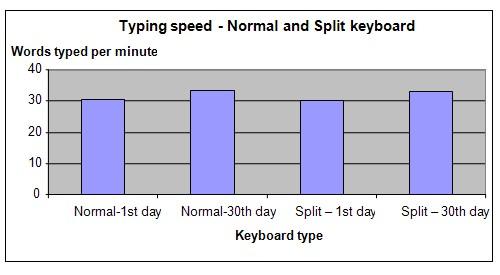| Complexity level: | 8 |
| Project cost ($): | 20 |
| Time required: | 1 day to prepare, 30 days for the science project experiment |
| Material availability: | Easily found |
| Safety concerns: | Basic safety requirements |
Hypothesis
There will be a significant difference in the speed of typing using a split keyboard and a normal keyboard. Typists using the split keyboard will be slower than those using normal keyboards.
Overview
The split keyboard
Before personal computers were invented, there were many professional typists who were properly trained in typing with proper wrist posture. Then in the 1980s, the personal computer invaded our offices and workspace all over the world. Suddenly, people with no previous training in typing postures and proper positioning of the hands were using keyboards intensively.
Over time, due to poor positioning of the hand and poor sitting posture, prolonged typing leads to various muscular skeletal injuries. The split keyboard was invented to overcome these injuries, caused by prolonged typing.
The split keyboard maintains the same configuration of keys as the normal keyboard. It is however, split in the center so that the wrists will remain straight and both the hands will not meet or cross at the keyboard.
Scientific Terms
Materials
The materials required for this science fair project:
- 20 students who regularly type everyday, for at least 2 hours
- 30 typing assignments
- 5 computers with normal keyboards
- 5 computers with split keyboards
- 1 stopwatch
Procedure
1. For this science fair project, the independent variable is the type of keyboard used. The dependent variable is the speed of typing, at the end of the month allocated for preparation/trianing. This is determined by using a stopwatch to count the words typed in 10 minutes and dividing the result by 10 to obtain words typed per minute. The constants (control variables) are the length of time allocated for practisingduring each session and the number of days for which the students continued practising.
2. 20 students who do regularly type everyday are selected. Their speed of typing is assessed on the first day of the science fair project using the normal keyboard. This is done by having the students type continuously for 10 minutes. At the end of the 10 minutes, the number of words typed is counted and divided by 10 to obtain the words typed per minute.
3. The students are then divided into 2 groups so that the average typing speed is almost the same for the students in both groups.
4. The students in the first group will continue to use the standard keyboard to practice typing assignments for an hour, for the next 30 days.
5. The students in the second group are introduced to the split keyboard. They practice typing assignments using the split keyboard for 1 hour for the next 30 days.
6. At the end of the 30 days, the 20 students are tested again for their typing speed. The first group is tested on the normal keyboard while the second group is tested on the split keyboard.
7. Their typing speeds are calculated and recorded in the table given below.

Results
The results show that all of the students have improved their typing speed at the end of the 30 days. However in comparing the average speed of students using the normal keyboard and the split keyboard, we were able to conclude that the average typing speed was the same for both keyboards.
|
Condition |
Typing speed – words typed per minute |
Average results |
|||||||||
|
1 |
2 |
3 |
4 |
5 |
6 |
7 |
8 |
9 |
10 |
||
|
Normal-day 1 |
32 |
28 |
29 |
36 |
26 |
30 |
29 |
35 |
31 |
28 |
30.4 |
|
Normal-day 30 |
35 |
31 |
32 |
39 |
28 |
33 |
31 |
38 |
35 |
31 |
33.3 |
|
Split – day 1 |
31 |
29 |
27 |
32 |
35 |
31 |
32 |
27 |
28 |
30 |
30.2 |
|
Split – day 30 |
33 |
34 |
31 |
35 |
37 |
32 |
35 |
29 |
32 |
33 |
33.1 |
The chart below represents the results of our science fair project.

Conclusion
The hypothesis has been proven to be false. There was no significant difference in the speed of typing using the split keyboard and the normal keyboard. The split keyboard was not a device invented to increase or decrease the speed of typing. It was created to prevent injuries due to prolonged typing. Whilst it took a while for the participants to get used to the split keyboard, eventually, they were able to get up to speed!
Most people benefit from using normal keyboards and are able to continue to use them for long hours without any injuries. However there are those who are unable to do so and suffer from wrist and shoulder pain/stress. Carpal tunnel syndrome is an injury attributed to long hours of typing – and it can be debilitating. For these persons, the split keyboard may be a better choice.
Also consider
The science fair project can be repeated to compare how long a person can continue to type on the normal keyboard compared to the split keyboard before becoming tired.
Try to repeat the science fair project to compare the number of words typed in a day using the normal keyboard and the split keyboard.
References
What is a split keyboard? - http://www.wisegeek.com/what-is-a-split-keyboard.htm
Computer keyboard design - http://ergo.human.cornell.edu/AHTutorials/ckd.htm

